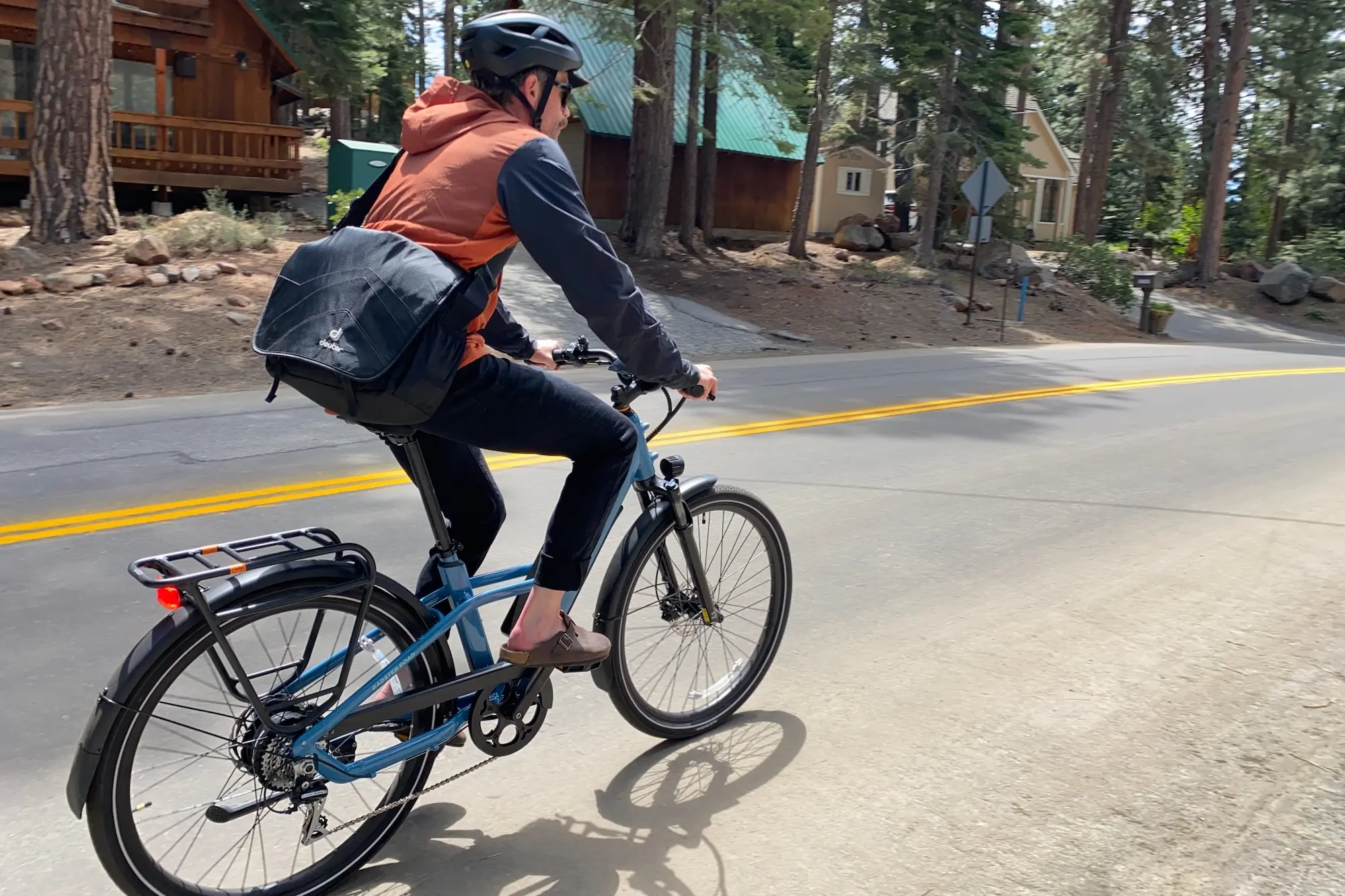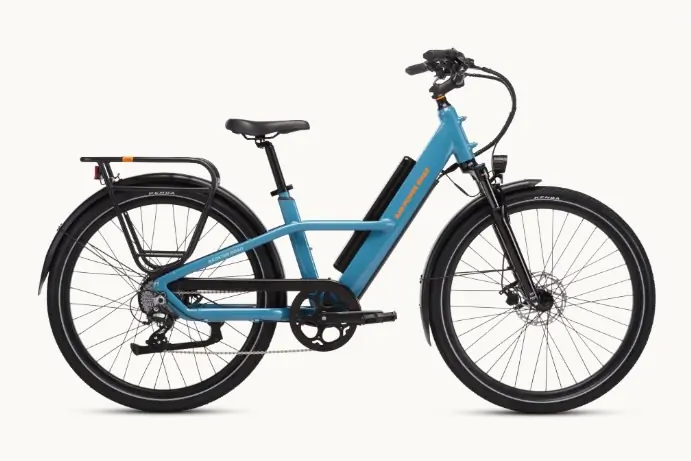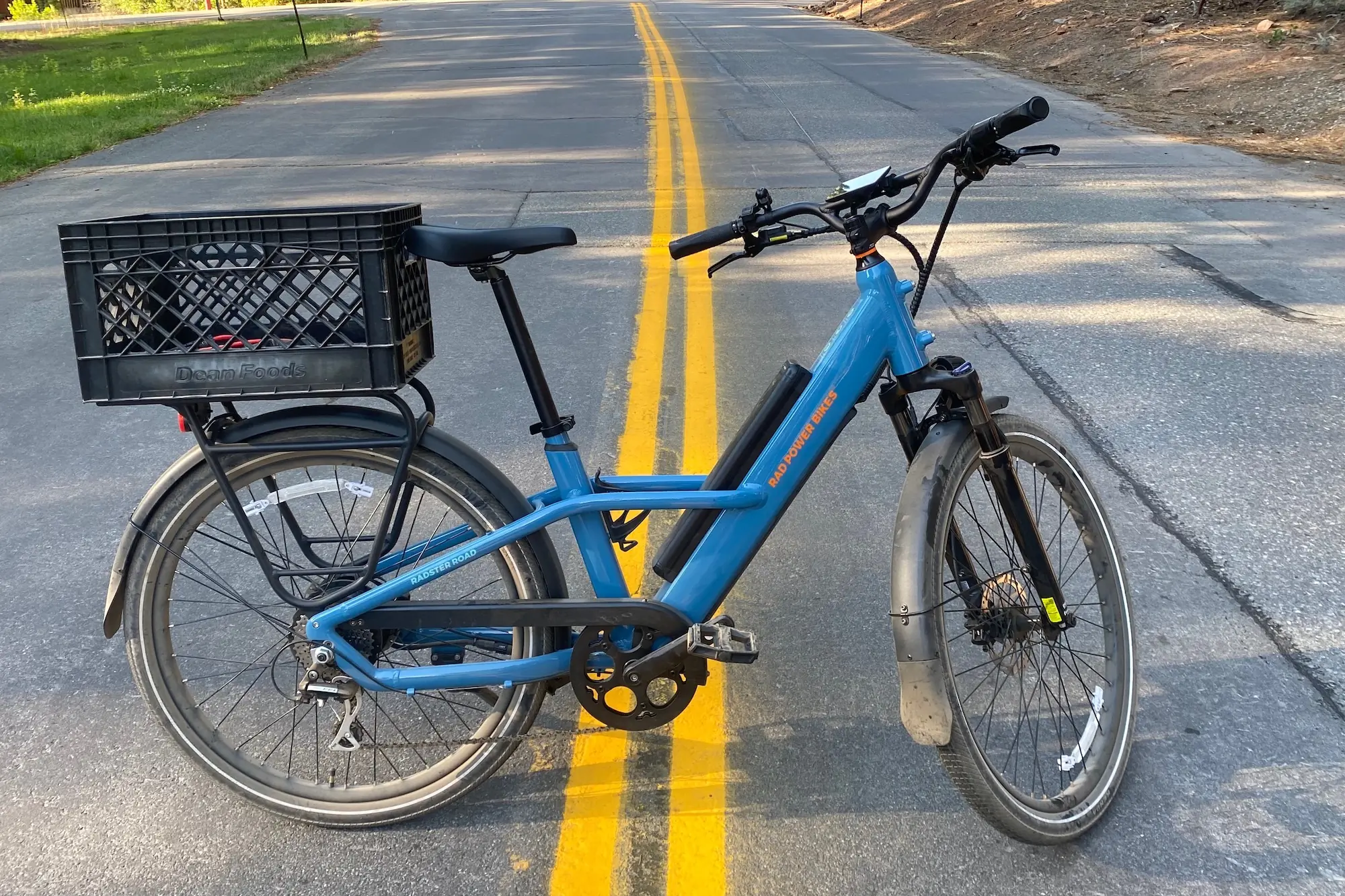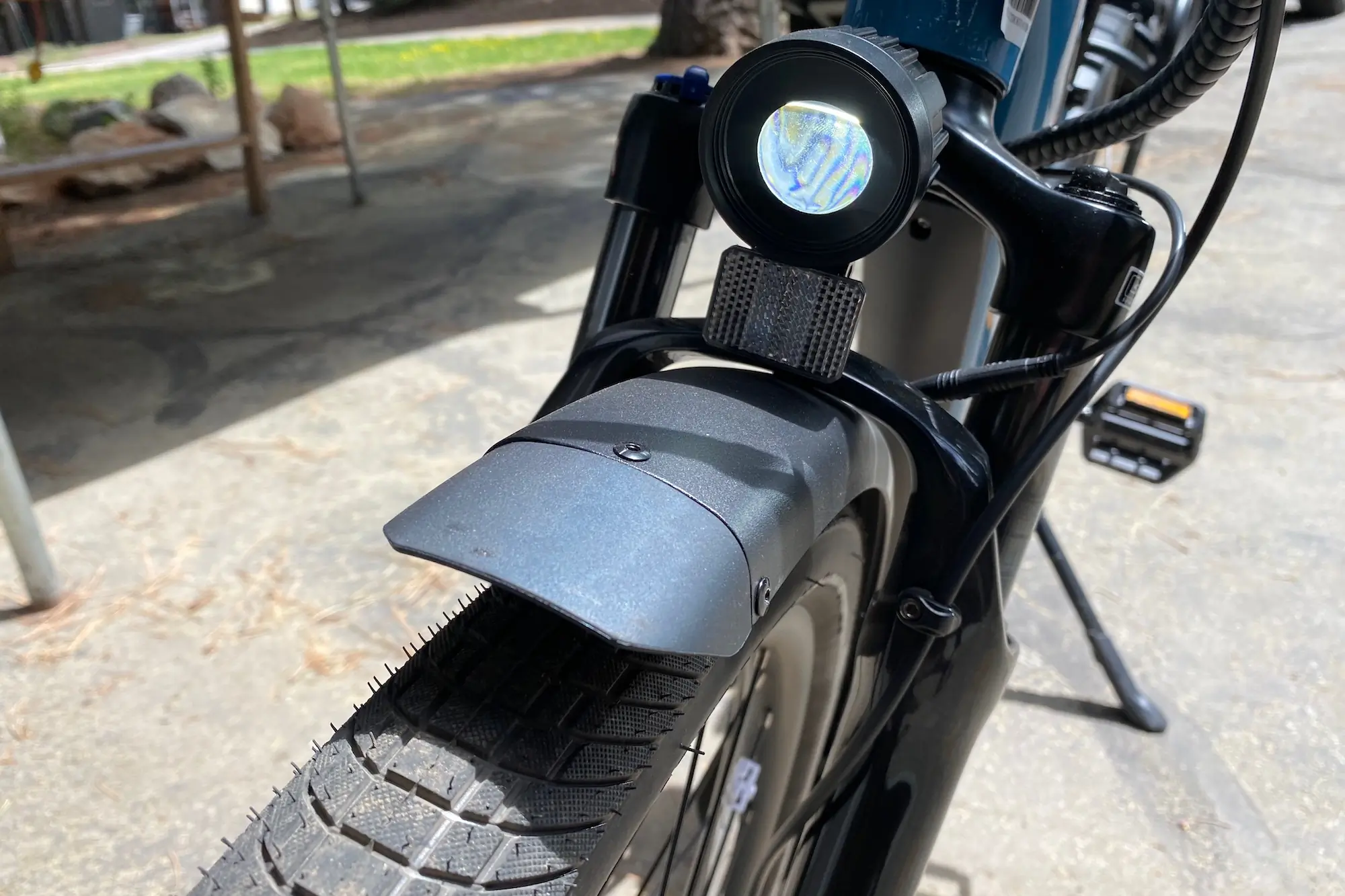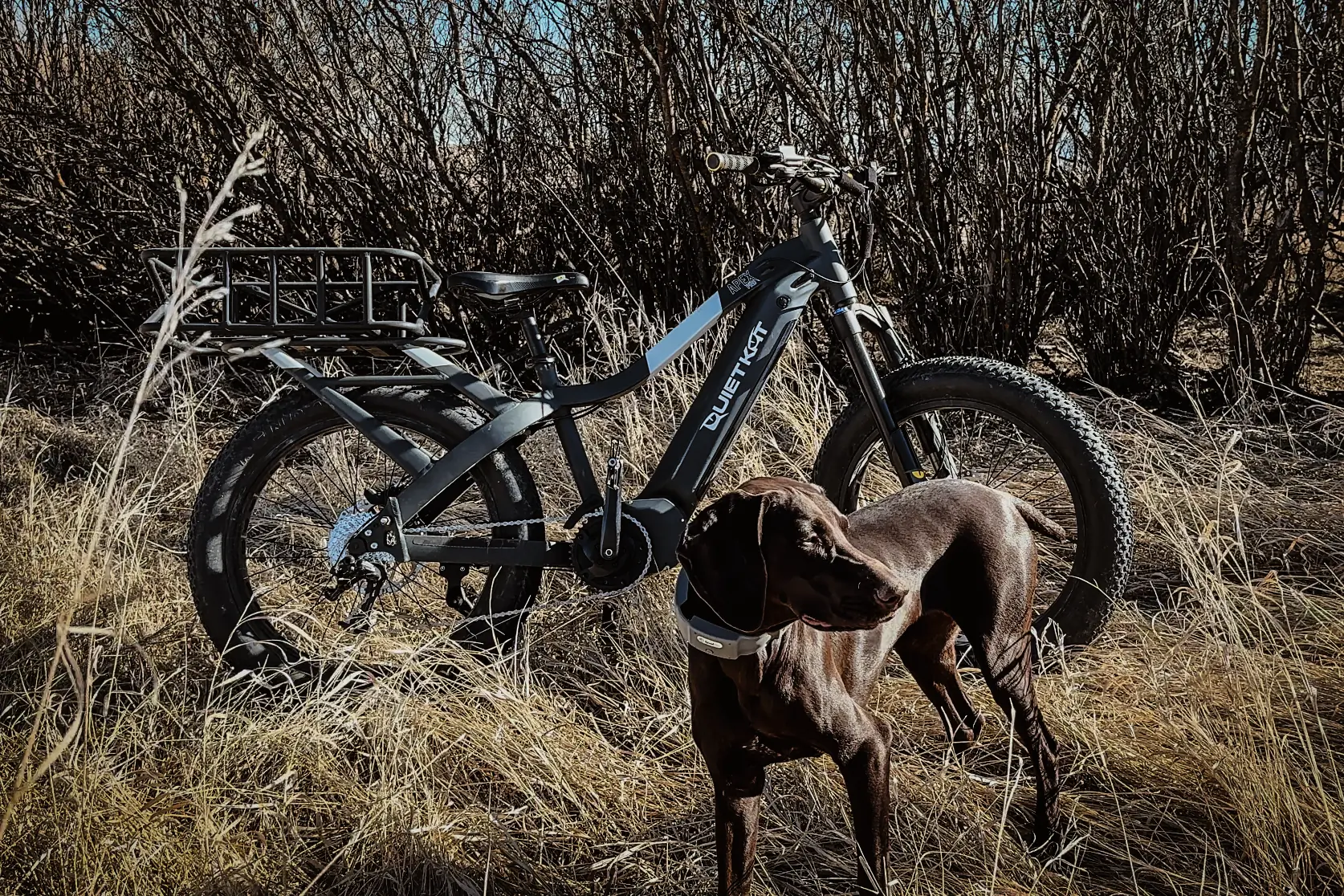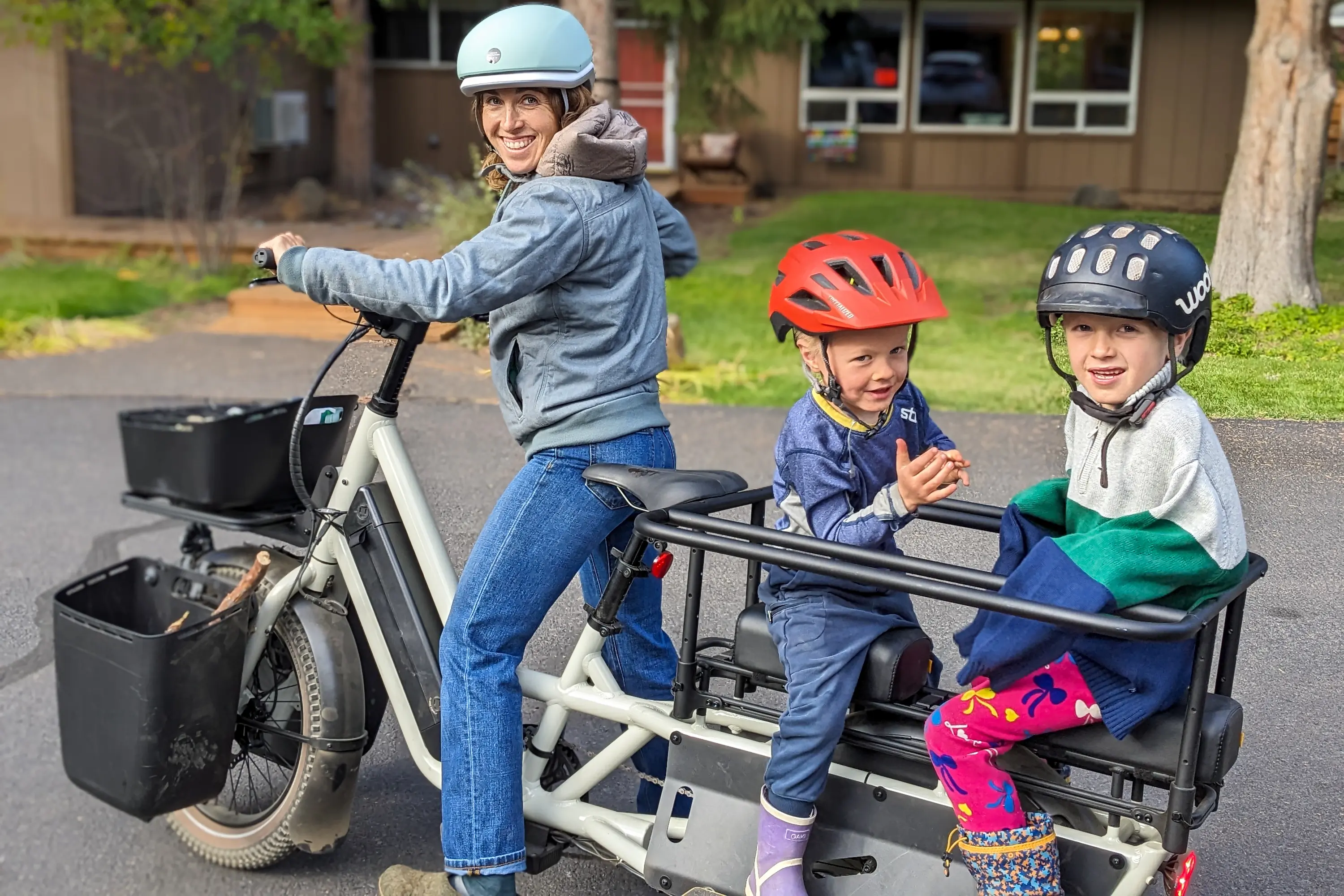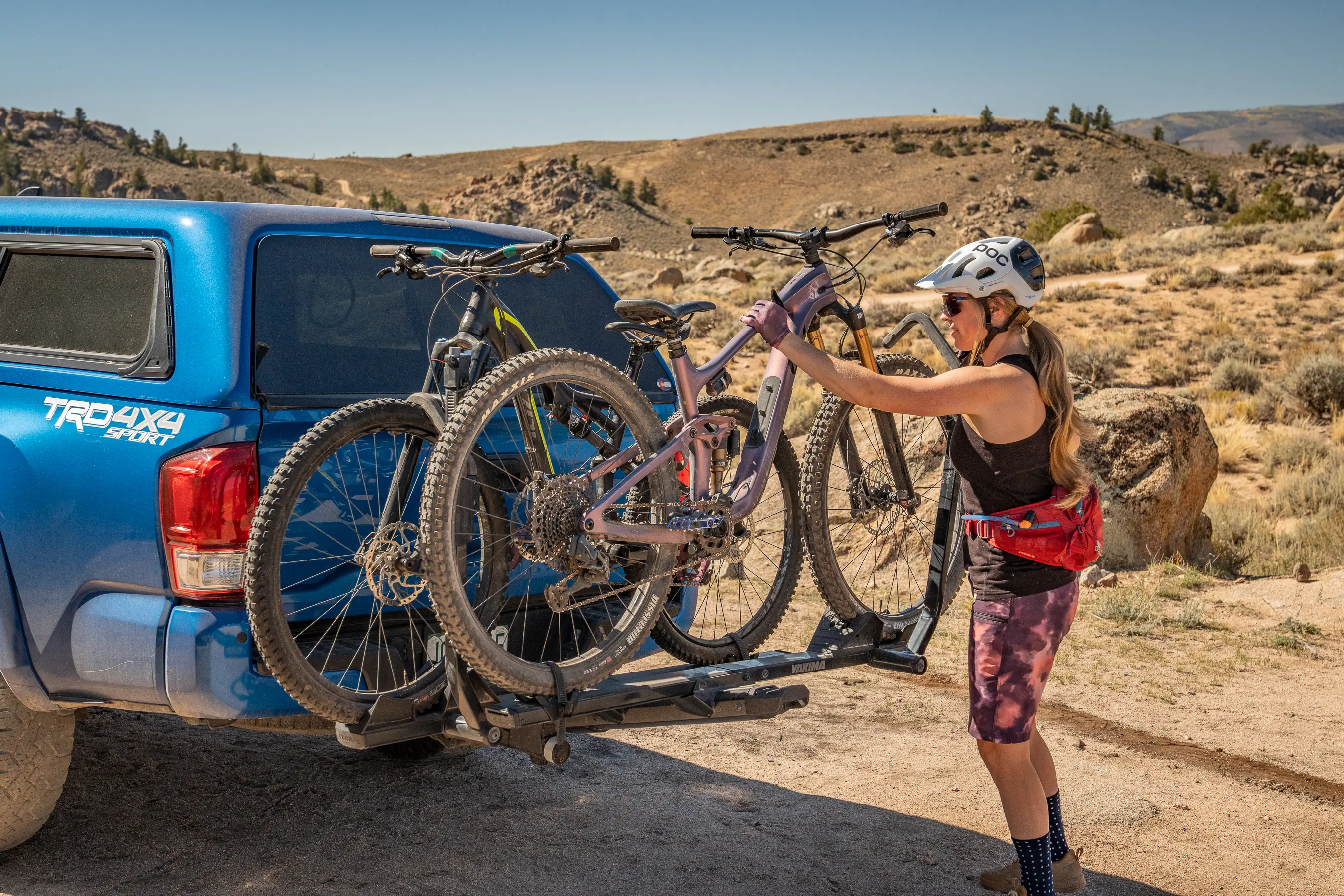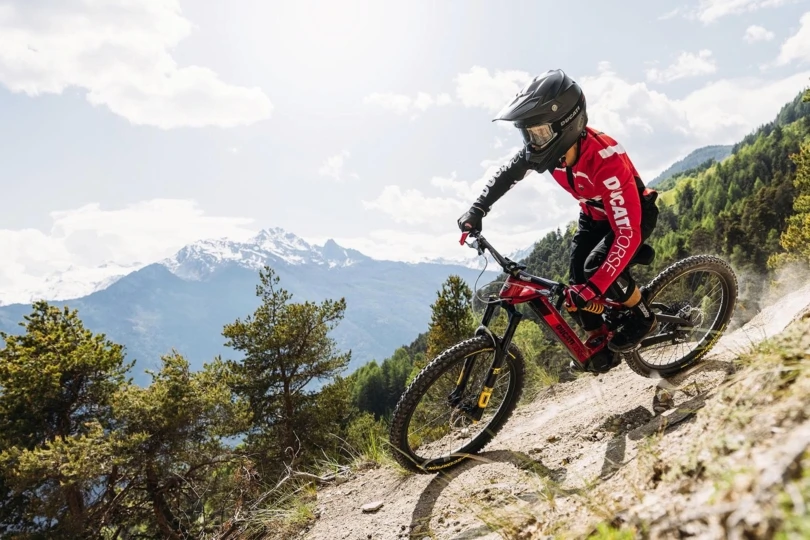Rad Power has been putting out quality, affordable electric bikes of all kinds for years and is one of the most popular electric mobility brands in North America. Rad’s product range runs the gamut from electric cargo bikes and folding models to adventure-ready fat tire bikes and commuters.
Earlier this year, Rad Power announced several major model updates and new models, including the Radster Road and Radster Trail. While the RadCity 5 Plus is still available, the new Radster Road essentially replaces it with an all-new frame design, Safe Shield battery, improved controls and display, 29-inch wheels, and Class 3 capability. Having ridden both, I can tell you the Radster Road is a superior bike in every way.
I’ve been testing the Radster Road ($2,199) for the past 3 months, and it has quickly become one of the most ridden bikes in my garage (my mountain and gravel bikes still see more use). I’ve put hundreds of miles on it running errands around town, riding to the lake and river for mid-summer cooldowns, and using it instead of my vehicle as much as possible. I’ve saved a significant amount of money on fuel, and I’ve had a blast riding around on this powerful, smooth, stable, and relatively affordable bike.
In short: Rad Power really stepped up its game with the new Radster Road electric commuter bike. Boasting Class 3 capability for pedal-assisted speeds up to 28 mph, 29-inch wheels for smooth and stable handling, and Safe Shield battery safety tech, this bike makes any ride easier and more fun. It may be slightly more expensive than previous Rad Power bikes, but it costs significantly less than premium models from other brands without sacrificing much, if any, performance.
- E-Bike Class: 3
- Motor: 750W rear hub
- Battery size: 720 Wh
- Wheel x Tire Size: 29" x 2.2"
- Drivetrain: 8-speed
- Suspension: 80 mm suspension fork
- Weight: 74 lbs.
Pros
- Smooth, stable handling
- Great range
- Capable of Class 3 speeds up to 28 mph
- Great e-bike controls and display
- Comes with rear cargo rack, lights, and fenders
- Reasonable price
Cons
- Very heavy
- Affordable but still not cheap
Rad Power Radster Road Review
I’ve been testing and reviewing electric bikes of all kinds for the past 6 years. In that time, I’ve tried a number of different Rad Power models including the commuter-oriented RadCity 4 and the RadCity 5 Plus. While the bikes have always been priced fairly and performed relatively well, they’ve always seemed a little bland to me, both in terms of performance and aesthetics.
The Radster Road bucks that trend and, in my opinion, elevates Rad Power into a new performance category. The new frame design, large wheels, torque sensor, Class 3 speeds, impressive range, and battery technology help to make this the best Rad Power bike I’ve ridden and arguably one of the best reasonably priced electric commuters on the market.

Assembly
Rad Power sells bikes direct to the consumer, so they typically get shipped right to your door in a large box with a little assembly remaining. They’ve been doing it this way for years, and fortunately, they’ve streamlined the process to make it relatively straightforward.
Still, there were a few steps involved, and it took me about an hour to get my Radster from the box to ready to ride. If you’re unsure of your mechanic skills or can’t be bothered with doing it yourself, take it to a local shop or one of the hundreds of service centers or retail partners listed on the Rad Power website — there are two in my small town.
If you choose to finish the assembly yourself, the biggest piece of advice that I can give is to follow the instructions. That starts with opening the box. Don’t open the top. Undo the clips at the bottom of the box, and then pull the box off the top — the lower part of the box supports the bike while you remove the protective materials and complete the first steps of the process.
A printed owner’s manual is included that details all of the steps — and the right order — to put the bike together, along with a small tool kit with all the tools you need. You also have the option to scan a QR code, which brings you to the Rad Power site, where you can download the manual or watch an assembly video. I won’t bore you with all the details, but the main steps include installing the handlebar, front wheel, front fender and headlight, and pedals.
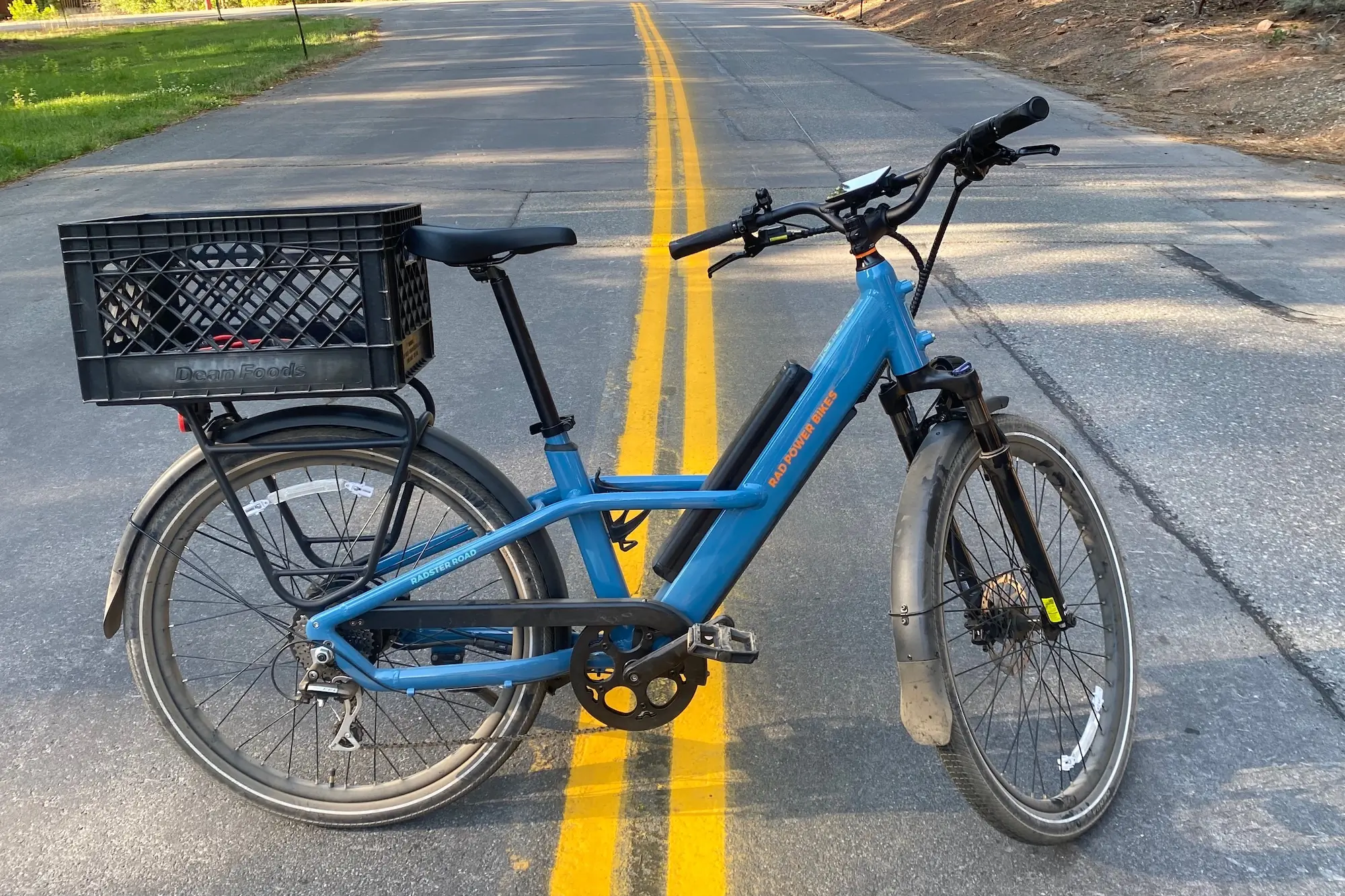



Frame Design
The new Radster models — both the Road and Trail versions — have a completely new frame design that sets them apart from other models in the Rad Power lineup. Instead of offering low-step and high-step frame options, it comes in just one frame style but two sizes to fit a large range of rider heights.
The Regular size is claimed to fit a rider height range of 4’11” to 5’8”, and the Large is intended for riders between 5’7” and 6’4”. At 6 feet tall, I fall squarely in the size large height range, but with a 34-inch inseam, I am completely maxing out the saddle height. That said, my 5’7” wife also fits on the bike, and a longer seatpost is an affordable fix for my issue.
Both frame sizes have relatively low standover and step-over heights — Regular is 22 inches, and Large is 24 inches — making it easy to mount and dismount the bike. There is a large range of seat height adjustability to dial it in to your needs within the intended rider height range. The reach is fairly short, and the riser handlebars are fairly high, making the seated pedaling position relatively upright and casual.
The 720 Wh battery is semi-integrated into the downtube of the frame for a pretty clean look. It isn’t quite as sleek as fully integrated batteries, but it’s a huge step up from the externally mounted batteries of old.
The battery can be quickly and easily unlocked and removed with the included keys for security or charging off the bike. A beefy rear rack is also included, and it can support up to 55 pounds of cargo. The Radster Road has a total payload capacity of 320 pounds and a 290-pound rider weight limit.
The beefy aluminum frames have an overbuilt look and feel and provide the confidence that they are ready to handle years of use. Sure, the frame — along with the battery and motor — contributes to the relatively heavy 74-pound weight of the bike, but it’s super sturdy and stable and is easily offset by the pedal assistance.
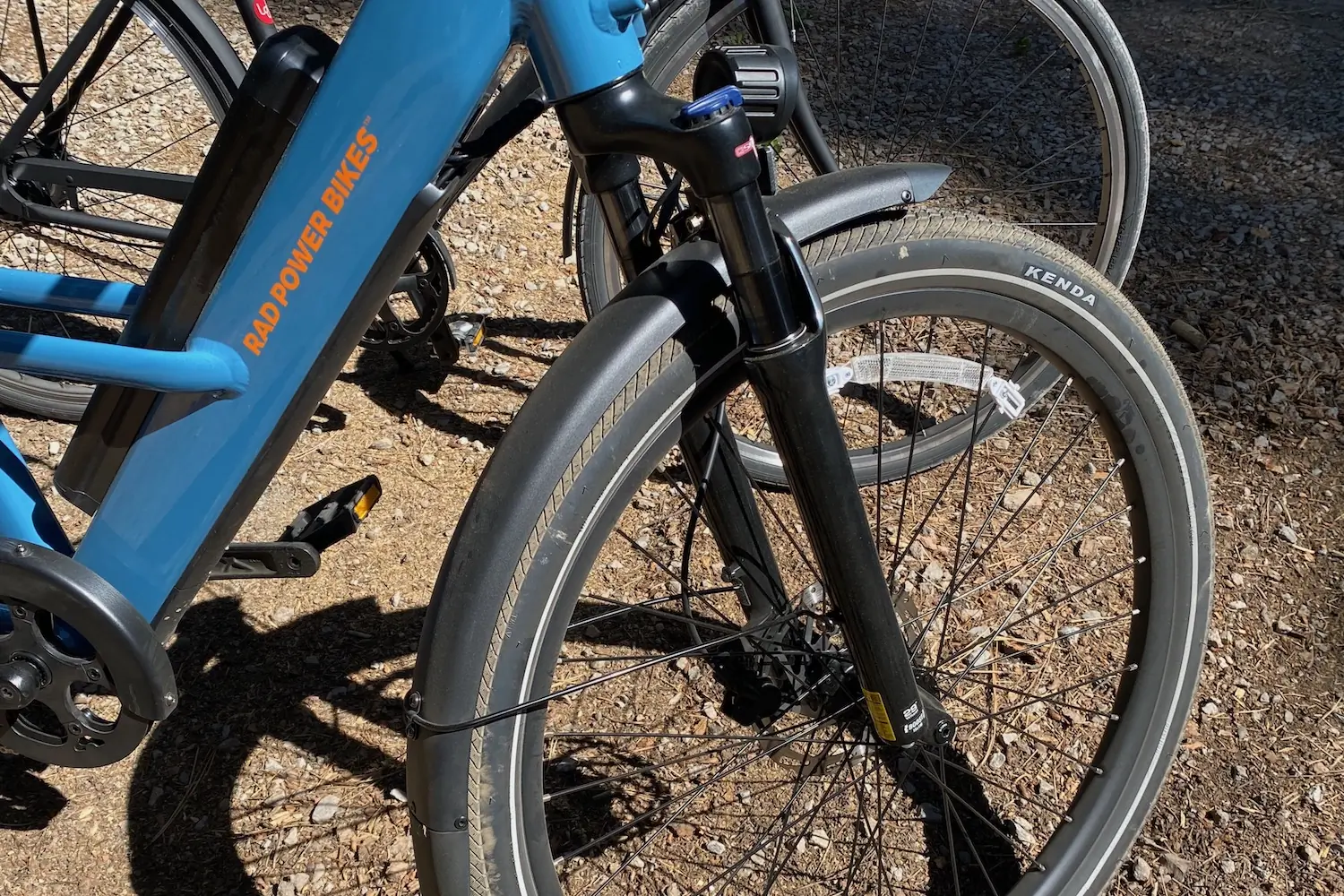



The Ride
One of the main things that stands out about the Radster Road is how smooth, stable, and natural its handling is. I’ve found this bike to feel impressively calm and composed at all speeds, with reassuring steadiness and predictability through turns of all shapes and sizes. There are several reasons for this, most notably the wheel size, tires, and front suspension.
For the Radster Road, Rad Power opted for larger, 29-inch wheels. Wheels this size roll fast and help smooth over imperfections in road surfaces like cracks and small bumps. They also help enhance stability at speed while contributing to the steady feel through turns.
When paired with the 2.2-inch wide Kenda Kwik tires, this combination provides ample grip and a fair amount of cushioning while remaining fast-rolling and super-smooth. These tires work best on paved surfaces but hold their own on smooth dirt and gravel as well. If you’re spending any significant time on dirt, however, you’ll probably be better off with the wider, knobbier tires on the Radster Trail.
The 80mm travel SR Suntour suspension fork also contributes to bump-smoothing comfort and control. This fork helps take the edge off impacts from large cracks, potholes, and cracked pavement while reducing harsh feedback transferred to the rider.
While bigger impacts don’t go completely unnoticed, it’s far better than a rigid fork. And, when combined with the 29-inch wheels and plump tires, this helps make the Radster Road a forgiving and comfortable ride.
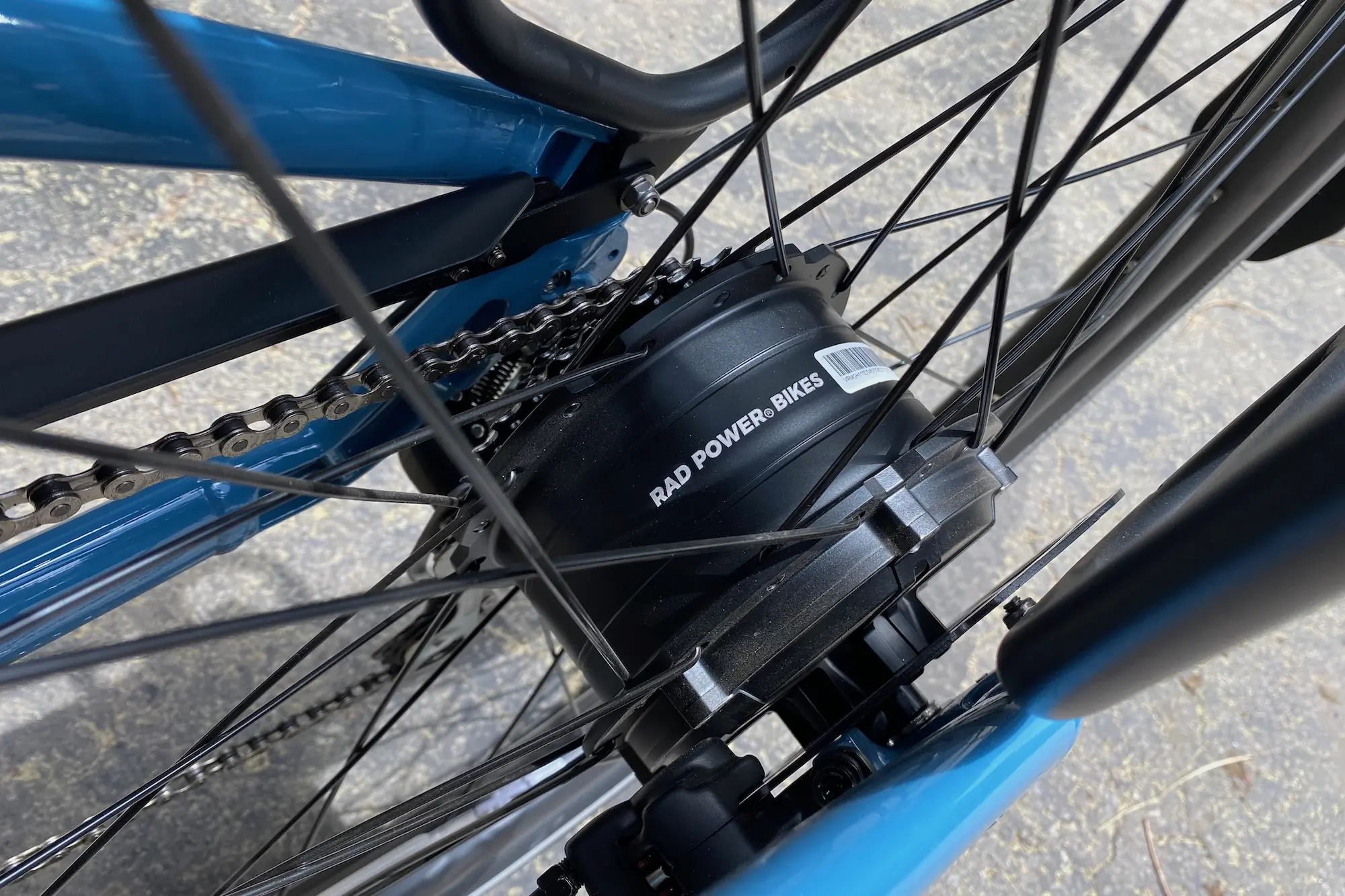



Power
Until I rode the Radster Road, all of the Rad Power bikes I’ve ever tested were Class 2, with a top pedal-assisted speed of 20 mph. You could increase the top speed slightly through the controls, but the fastest I’d ever gotten any of them to go was around 23 mph.
While 20 mph might be plenty fast for a lot of riders, the inability to bump up to Class 3 speeds — 28 mph using pedal assist — has been one of the primary drawbacks of previous Rad Power bikes.
Well, not anymore. With the Radster Road, Radster Trail, and the updated RadWagon 5, Rad Power now gives riders the option to ride at Class 3 speeds up to 28 mph using pedal assist. The bikes ship in the Class 2 settings, but it’s quick and easy to change to Class 3 through the controls.
With a powerful 750W rear hub motor that puts out up to 100 Nm of torque, the Radster is willing and able to zip along at 28 mph on flat ground in its highest pedal assist mode. You don’t have to ride it that fast, of course, and you can leave it in its Class 2 settings or use lower pedal assist levels depending on the situation.
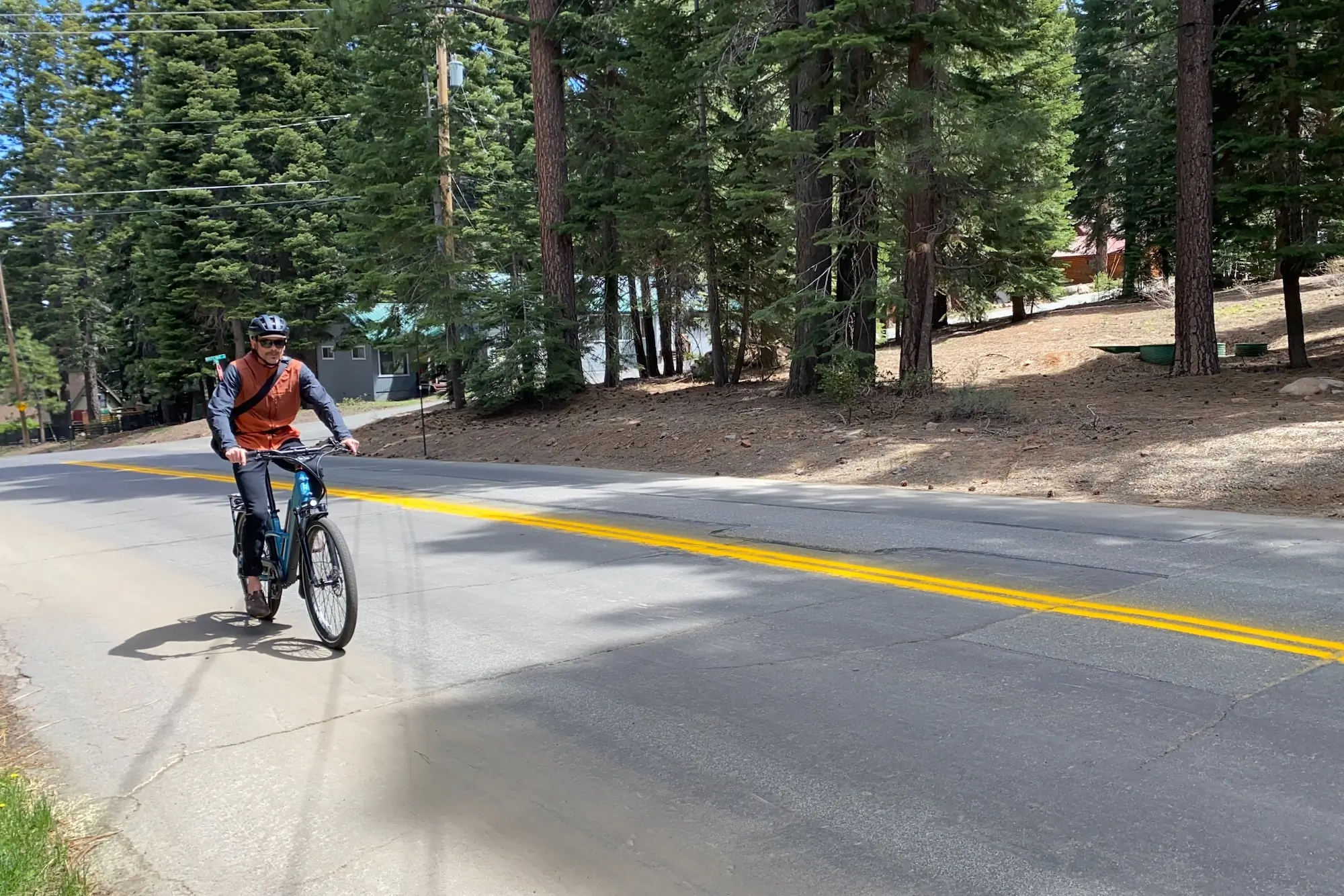



Personally, I really enjoyed being able to go that fast when ripping into town to run errands or when keeping up with traffic. And, with a whopping 100 Nm of torque, you can absolutely fly up hills as well. You’ll be hard-pressed to go 28 mph uphill, but the Radster makes steep inclines virtually disappear.
Speaking of torque, the torque sensor is another upgrade that helps the power delivery feel more refined and natural. The pedal assistance ramps up along with your pedaling effort, as opposed to cadence sensors that can feel very jumpy and jerky when you start pedaling.
In terms of the quality of the power output, I found the rear hub motor of the Radster Road to feel quite similar to some of the mid-drive-motor-equipped bikes I’ve ridden recently. Mid-drive motors are touted for their more refined performance, but the torque sensor on the Radster puts it nearly on par in my book, while feeling a touch more powerful and providing the option to have a throttle, too.
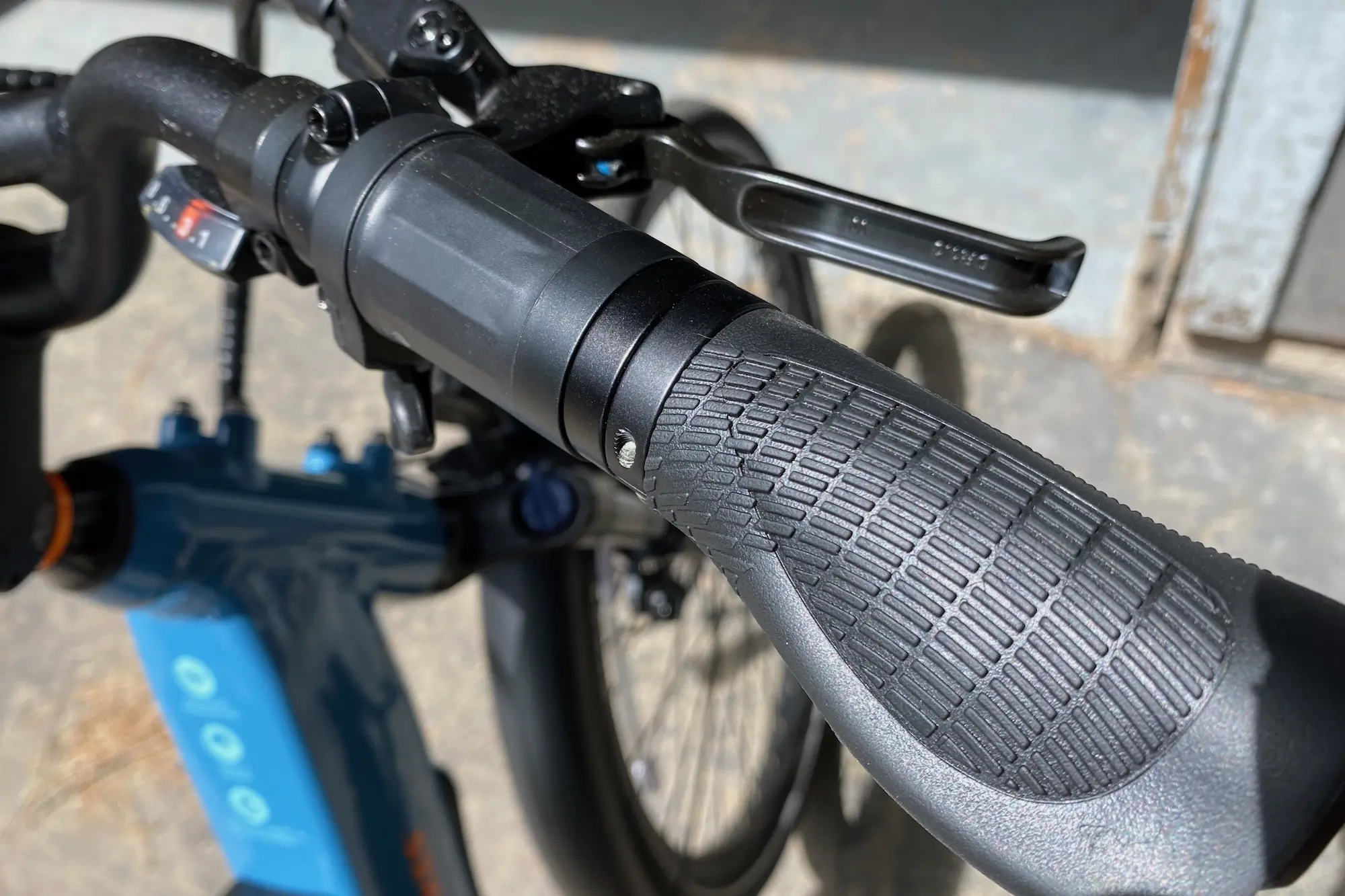



The throttle is another nice feature of the Radster Road. By simply twisting the throttle integrated into the right grip, the motor can push you along at up to 20 mph.
I’m quite partial to pedaling bikes while riding them, but I found it to be very helpful when starting from a complete stop at intersections and the occasional lazy cruise to the neighborhood swimming hole. Unlike the pedal assistance, the throttle is a bit more on/off, but you can modulate it slightly depending on how far you twist it.
Battery and Range
The Radster Road comes with a 720Wh (15Ah) battery that provides an impressive range. The larger the battery, the farther you can ride, and 720 Wh is about as big as it gets for bikes of this style. Rad Power claims an estimated 25 to 65 miles per charge, which is a fairly large range, but I’d say it’s relatively accurate.
Of course, there are a lot of factors that play into how quickly you drain your battery, including pedal assist level, throttle usage, riding up hills, rider weight, pedaling input, cargo weight, etc. Still, even when blasting to and from town in pedal assist level 5 at 28 mph, I was easily able to get 25+ miles before needing to plug it in again.
On one slower-paced ride, my wife rode for over 45 miles while switching between assist levels 2 and 3. So, how far you can go on a single charge will depend on how you ride it, but there’s ample juice to cover some serious ground.
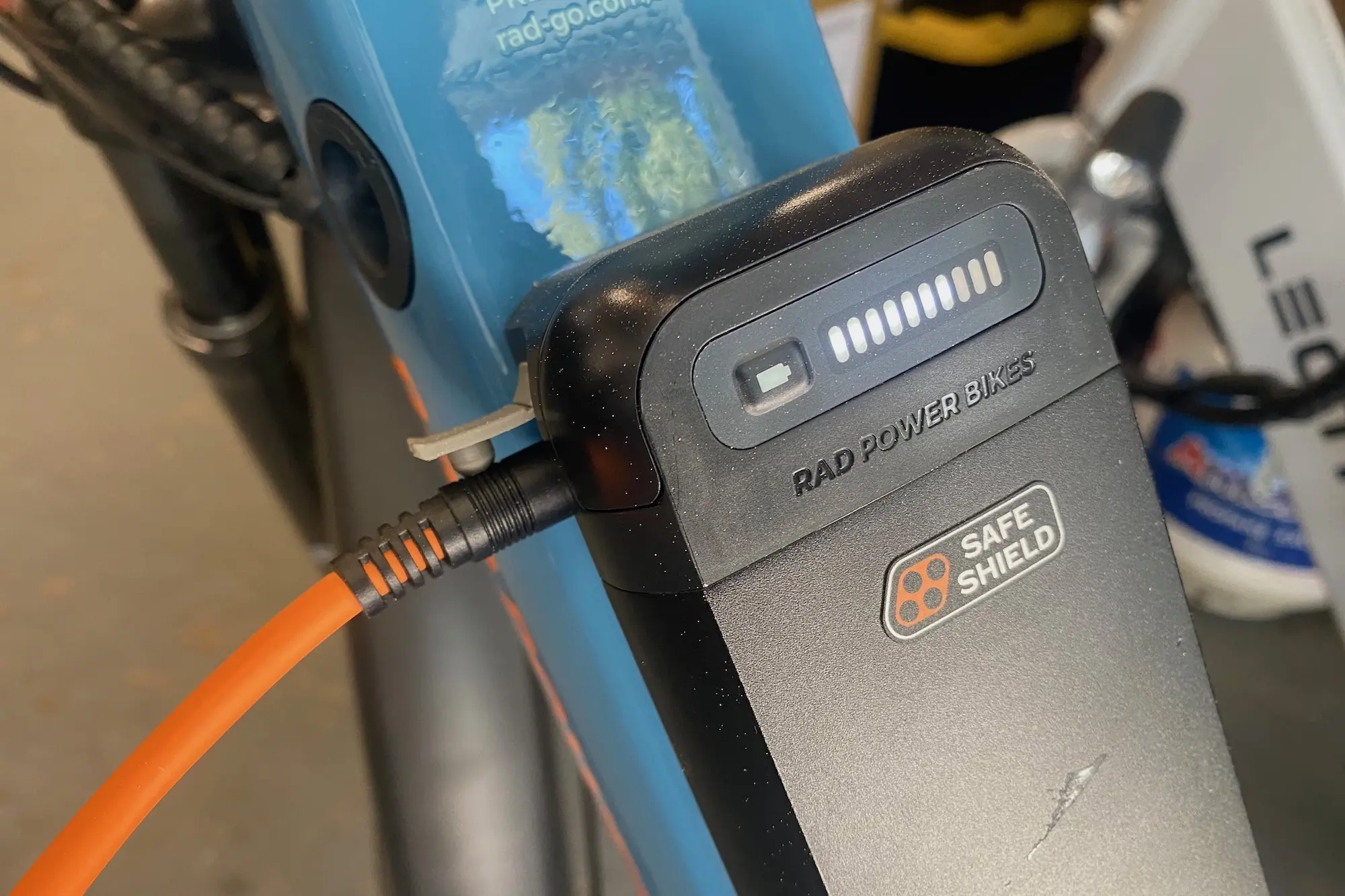



When Rad Power launched its new models, it also introduced the Safe Shield batteries. Electric bike battery fires have become a problem and can be incredibly dangerous, and the Safe Shield battery technology aims to address that issue. Not only are the batteries and the electrical system UL-certified to UL-2849 and UL-2271 standards, but Rad Power has also designed them specifically to reduce the risk of fire.
Each cell within the battery is “encapsulated in a unique heat-absorbing resin” to provide thermal resistance. This way, if one cell is compromised, it aims to prevent the spread of heat between cells, which could result in thermal runaway that could create a fire.
The battery is semi-integrated into the bike frame, but it is easily removed using the included key if needed for security or charging purposes. A small rubber flap on the left side of the battery is easy to open and close when you need to plug in the charging cable. Additionally, all of Rad Power’s 2024 models, including the Radster Road, are rated IPX6 for weather protection, meaning they are designed to withstand heavy and high-pressure water splashes.
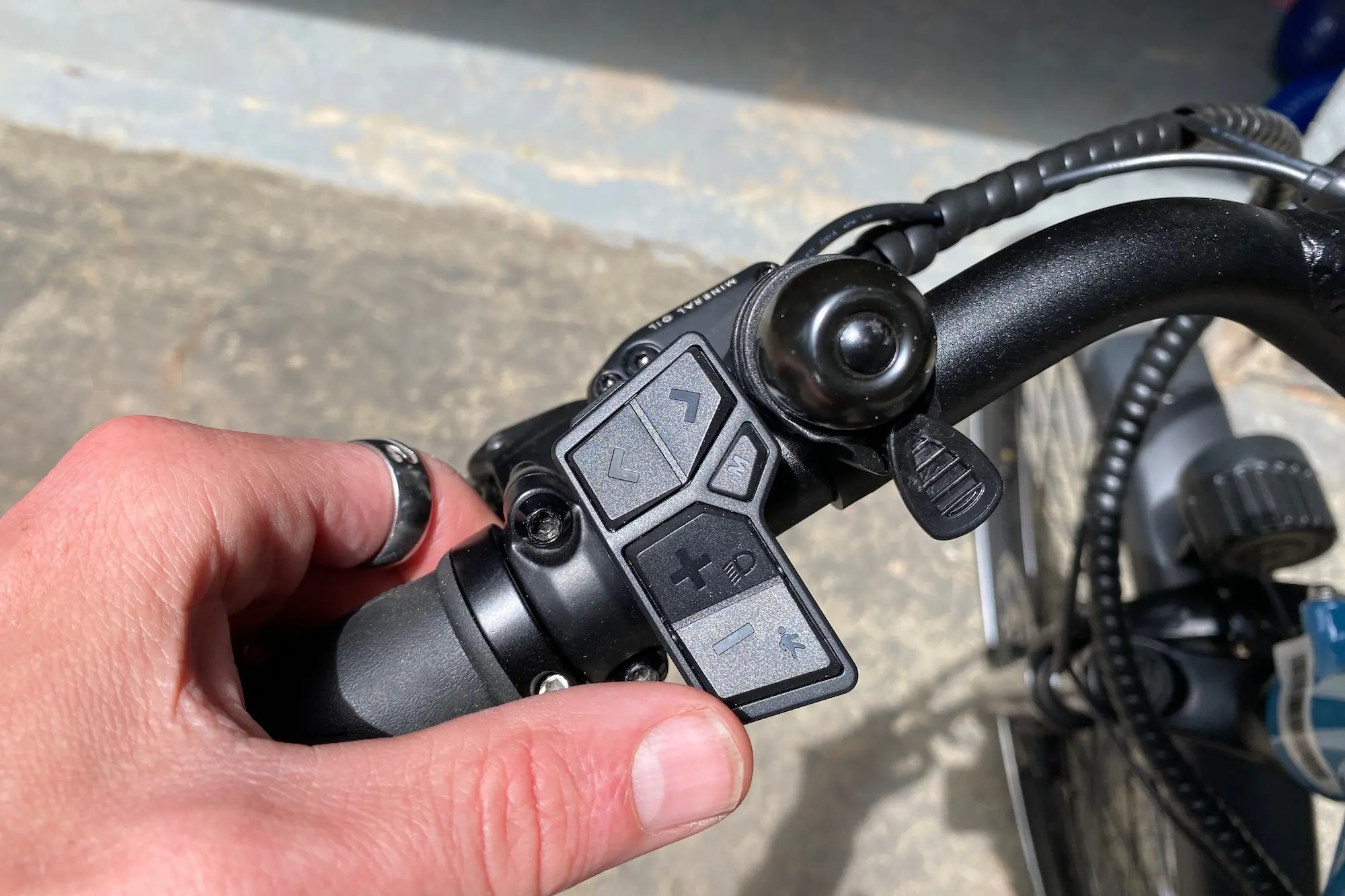



Controls
Another area that saw notable improvement over previous Rad Power bikes is the controls and display. While Rad’s controls were never bad, the latest version on the Radster Road is a major upgrade. The control unit’s ergonomics are good; the display is large, easy to read, and understand, and shows all the important information you need at a glance.
Situated next to the left grip, the all-in-one control unit contains all the buttons with an intuitive layout. The power button and the menu button are both small and out of the way, while the pedal assist and turn signal buttons are much larger and easy to reach with the thumb while riding.
The assist level and turn signal buttons are also used to scroll through the menu when you need to change any of the bike’s settings, like top speed, units, etc. Integrated into the right grip is the half-twist throttle that works well when you want to propel the bike under full electric power.
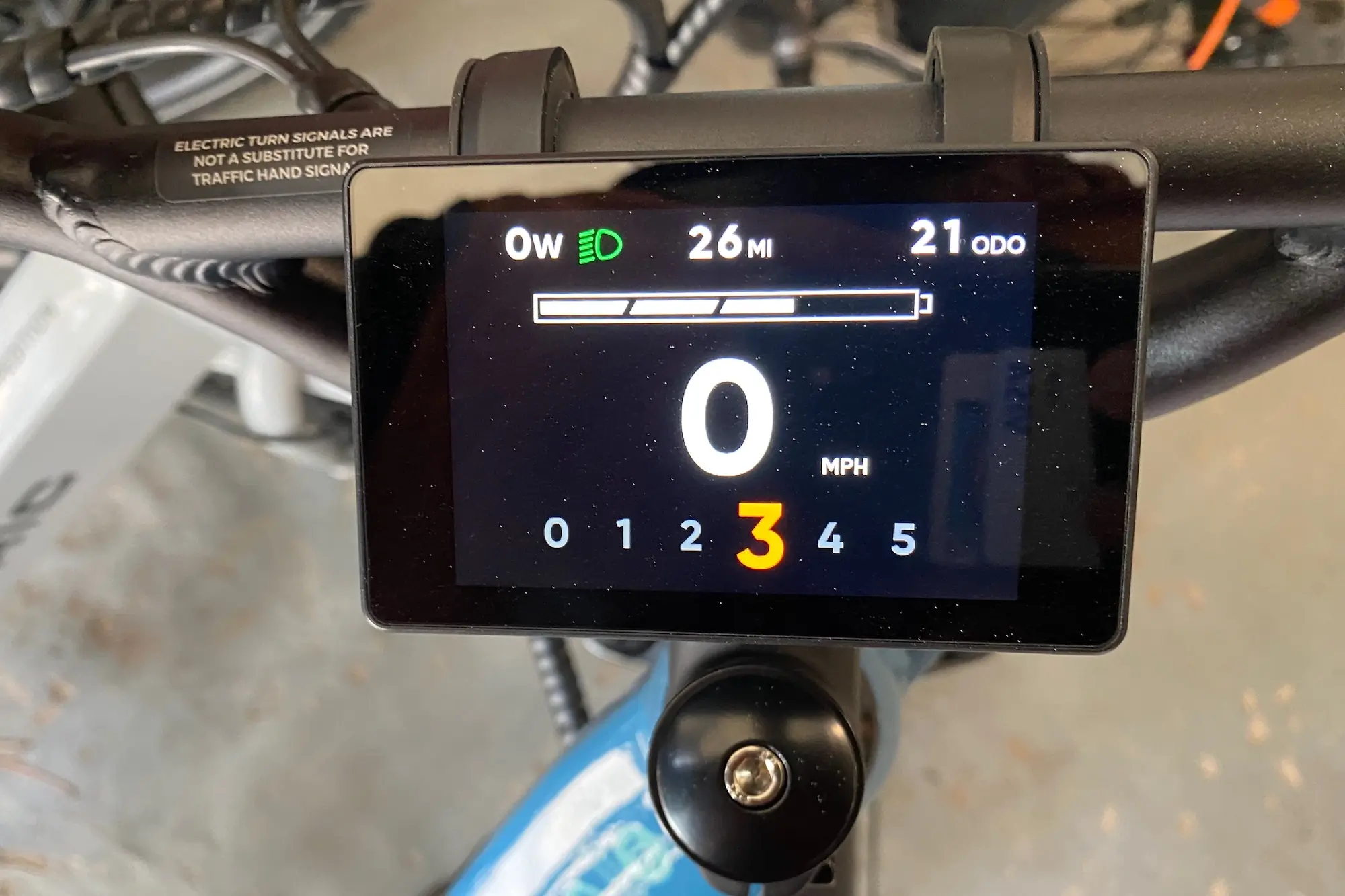



The display is centered on the handlebar and is very easy to read while riding. It’s 3 inches wide and 2 inches tall with a screen that seems to have an antireflective coating. I never experienced excessive reflection or glare from the screen, even on bright, sunny days.
The color display has a black background with bright letters and numbers. Speed is displayed most prominently in the middle, along with the pedal assist level across the bottom, battery level as a small graphic and a percentage (or estimated remaining distance if you prefer), odometer, and motor output in watts. You also have the option to customize some of the information fields to your liking.
The bike’s menu is also incredibly easy to use and navigate when you need to make any changes. It’s impressively straightforward to switch between classes (top speed), units, and more with the control buttons and the large, clear color display.
Last but not least, you can lock and unlock the bike’s controls with the included fob or add a personal passcode for an extra layer of security. This makes it so others won’t be able to turn on and operate your bike without the fob or code.
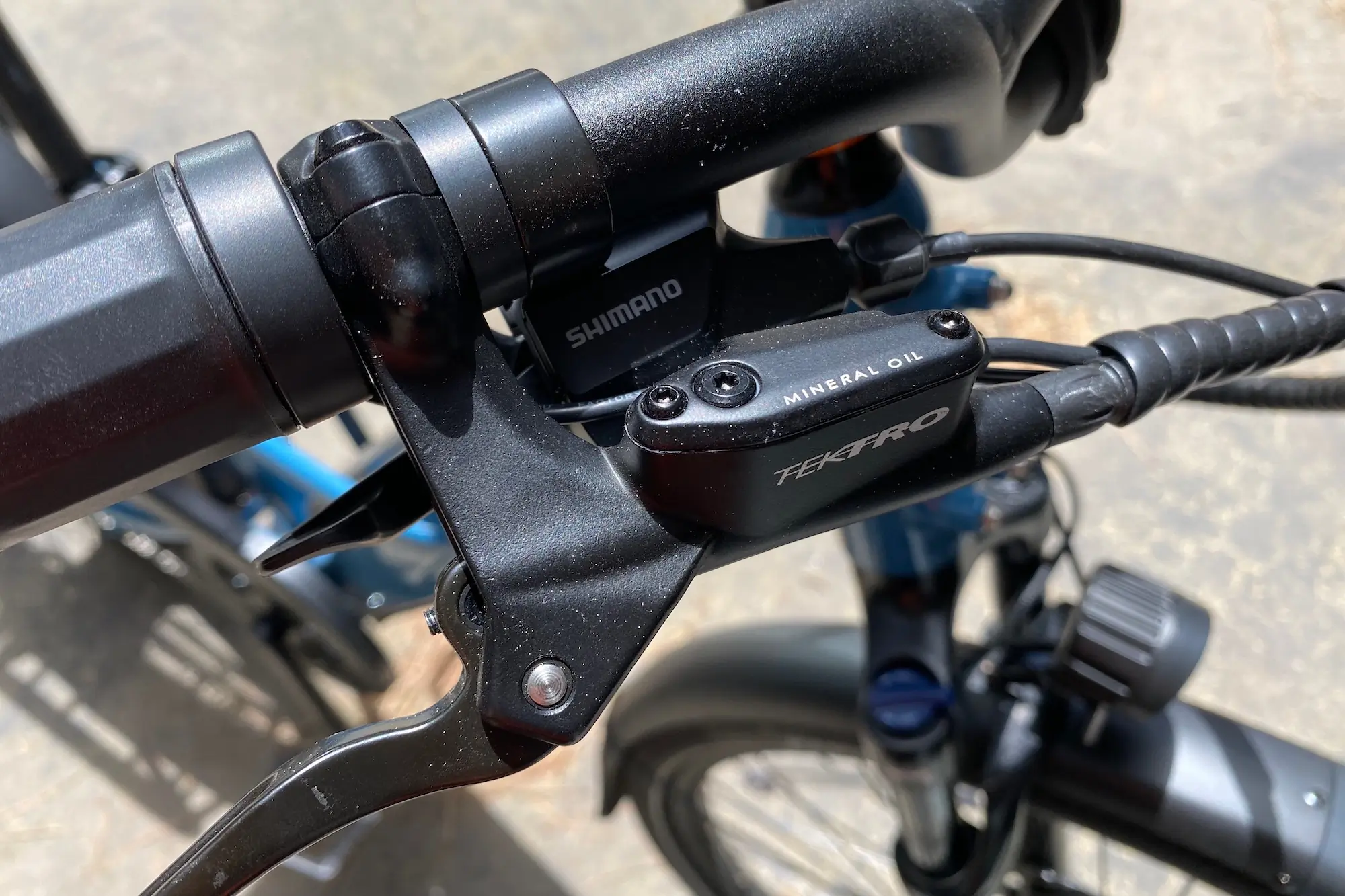



Components
With a heavy weight and powerful motor capable of supporting pedal-assisted speeds up to 28 mph, controlling your speed is of the utmost importance. Rad Power did a commendable job by equipping the Radster Road with powerful Tektro hydraulic disc brakes with 180mm rotors front and rear.
I found these brakes to provide confidence-inspiring stopping power while avoiding feeling over or underpowered. Like most electric bikes, the brakes also have a power cutoff feature that kills the motor power when they are engaged.
The Radster comes with an eight-speed Shimano drivetrain that offers a fairly large gear range. I live in a hilly area and appreciated having easier gears for climbing the hills back to my house, even with pedal assistance.
Rad Power smartly chose trigger-style shifters, which work well and are a big step up in performance from those found on many affordable electric bikes. The ergonomic rubber grips also proved to be quite comfortable, as did the mid-size seat with an anatomic pressure relief cut-out.
The wheels also deserve mention. Given the weight and speeds of the Radster, the brand needed to put some tough wheels on this bike, and these feel up to the task. I’ve smashed into many pavement cracks and have definitely taken it down some rocky trails where it doesn’t belong, and they look no worse for the wear.
The wheels are also attached with beefy through-axles to provide a super secure connection to the bike and handle the weight, forces, and power of Radster. One last detail that I appreciated was the alloy platform pedals, which have a large surface area and provide good grip and ample foot support.
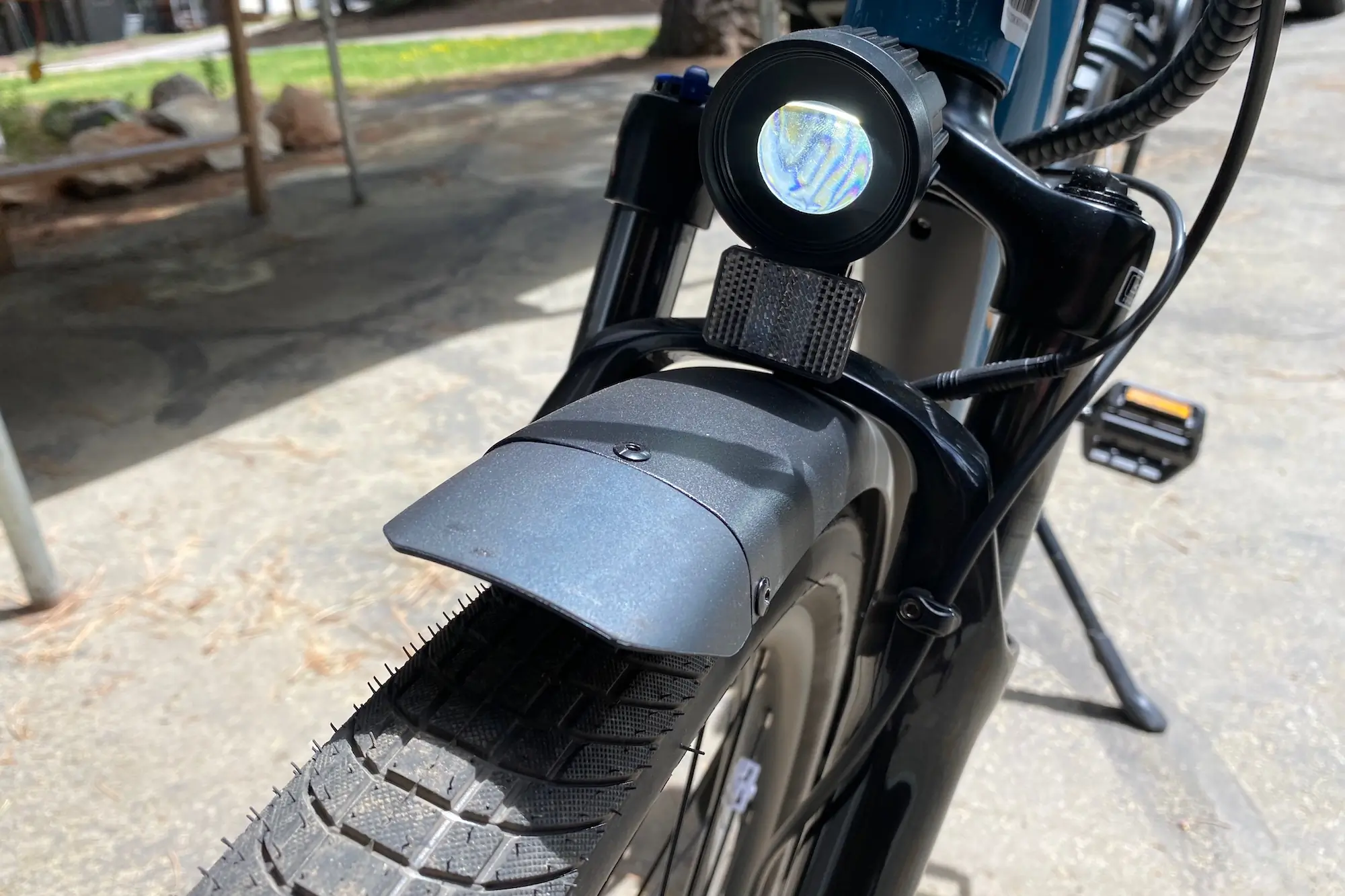



Features
With commuting in mind, Rad Power did an excellent job equipping the Radster Road with features that will make your rides safer and more enjoyable. This bike comes fully decked out with everything you need, with the exception of baskets or panniers to carry your gear — although Rad Power sells a full range of compatible accessories to dial it in to your needs.
Seeing and being seen on the road is incredibly important for your safety, and Rad Power seriously upgraded the lights on the Radster Road. Both the front and rear lights run off the bike’s battery, so you’ll never need to charge them.
The rear light helps you be seen from behind, functions as a brake light when you squeeze the brake levers, and has turn signal functionality with a push of a button on the controls. The front light is a 200-lumen LED that makes you clearly visible to oncoming motorists and is actually bright enough to light your way in the dark. While the front light does work quite well, I’d still recommend adding an aftermarket helmet or handlebar-mounted bike light if you’re riding in the dark regularly.
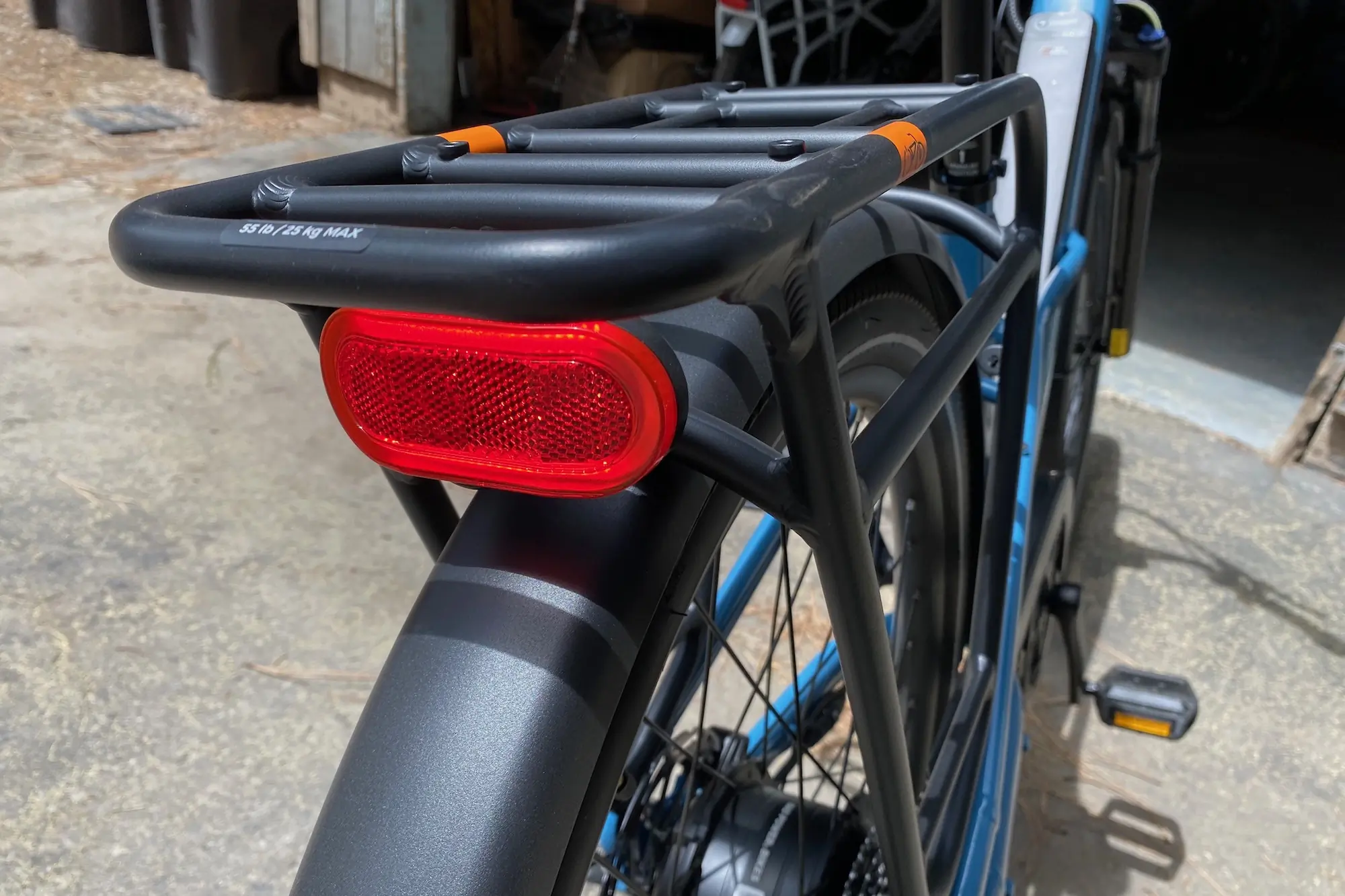



Full-coverage metal fenders provide excellent protection from road spray if you ride through a puddle or get caught out in an unexpected storm. A chainguard protects your pant leg from getting greasy on the way to work, and a sturdy kickstand keeps your bike upright when parked.
The integrated rear rack can support up to 55 pounds of cargo and is designed to fit a range of accessories like baskets, panniers, or the Thule Yepp Maxi Child Seat. I strapped a large plastic milk crate on mine and had ample space for grocery runs or carrying my gear to the beach. Additional mount points on the head tube fit front baskets, and a bottle cage mount on the seat tube assures you can keep water close at hand.
Rounding out the features of the Radster Road is a bell that helps you warn other folks that you’re coming. While bells are an inexpensive add-on, it’s nice that it already comes with one and you don’t have to install it yourself. The aforementioned Safe Shield battery and one-touch fob security are also great safety and security features.
Weight
With a sturdy frame, large battery, powerful motor, suspension fork, beefy wheels, and a rear rack, the Radster Road is no lightweight. At 74 pounds, this bike is heavy, even compared to other electric commuter bikes.
While riding, however, I found the weight to go largely unnoticed, thanks to the smooth handling and powerful motor. The same can’t be said for riding it without power, as it feels like you’re pulling an anchor behind you. It’s best to avoid draining the battery completely to avoid having to ride it without any pedal assistance.
The weight also makes the Radster quite difficult to transport by vehicle since most bike racks aren’t rated to carry bikes this heavy, and loading it onto a rack is a real challenge — unless you have a rack with a high weight limit and a loading ramp.
Likewise, it’s not a bike you want to carry up and down stairs, or anywhere else for that matter. The Radster is best stored in a garage or other space that you can roll it in and out of easily.
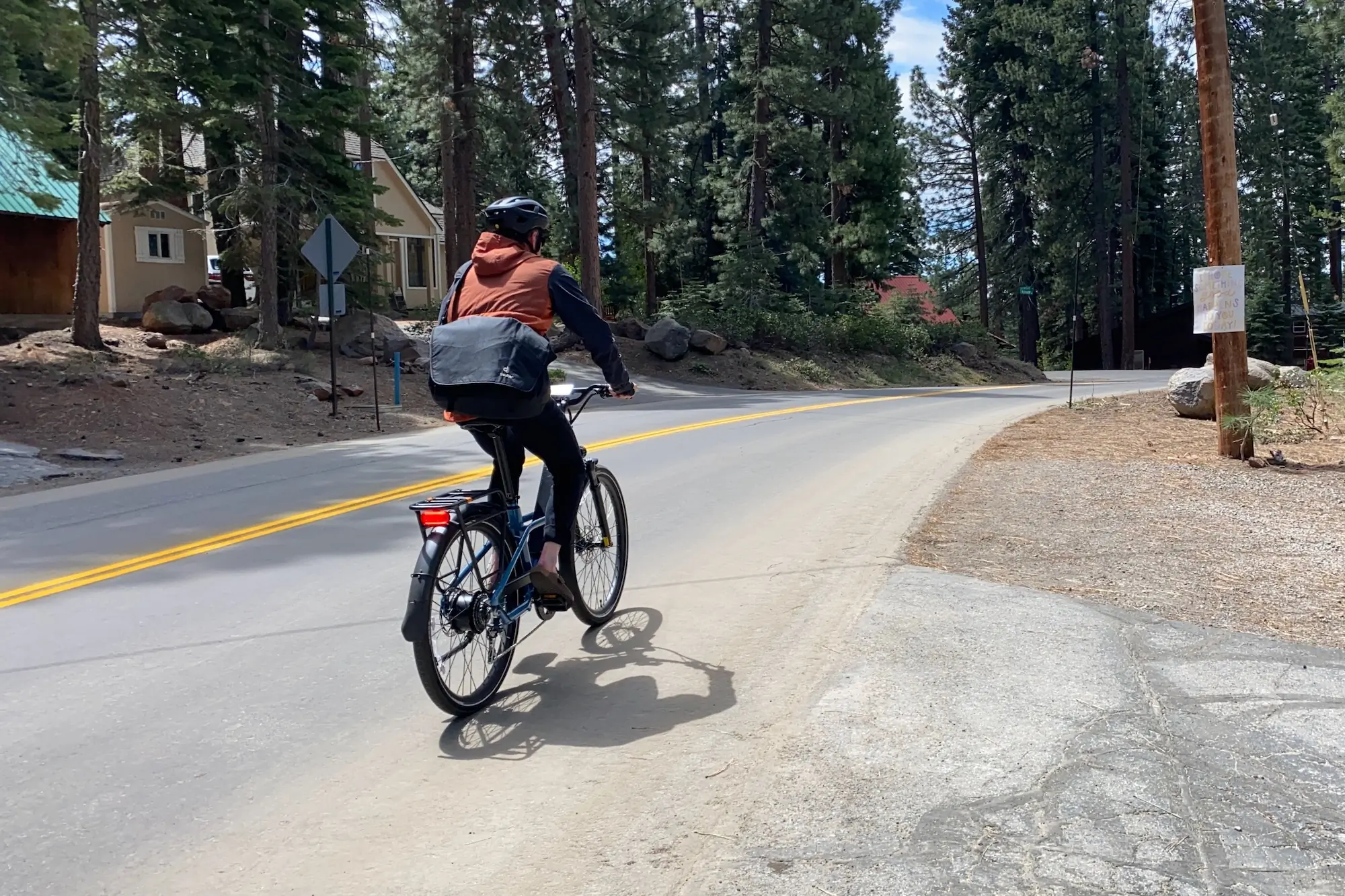



Conclusion
By producing quality electric bikes and selling them at reasonable prices, Rad Power has helped fuel the popularity of e-bikes and has become a household name. But with so many electric bike brands these days, Rad has more competition than ever. Instead of resting on its laurels, Rad Power continues to innovate and improve its bikes, as evidenced by the new Radster Road.
The Radster is a major step up in performance and quality compared to other Rad Power commuter bikes that I’ve tested. Those bikes were good, but the Radster beats them in speed, power, handling, controls, features, and safety.
If you can’t tell, I really like this bike. It has become my daily driver, and after riding it everywhere for the past few months, I can’t imagine life without it. That’s not to say there aren’t better electric commuter bikes out there, but I think you’d be hard-pressed to find a better-performing bike for the price.
Still, $2,199 is no drop in the bucket. But, I feel the expense is easily justified, and this bike will eventually pay itself off when you drive less and ride more. Not to mention all the fun you’ll be having.
You can buy the Radster Road at one of Rad Power’s retail partners or on its website.
